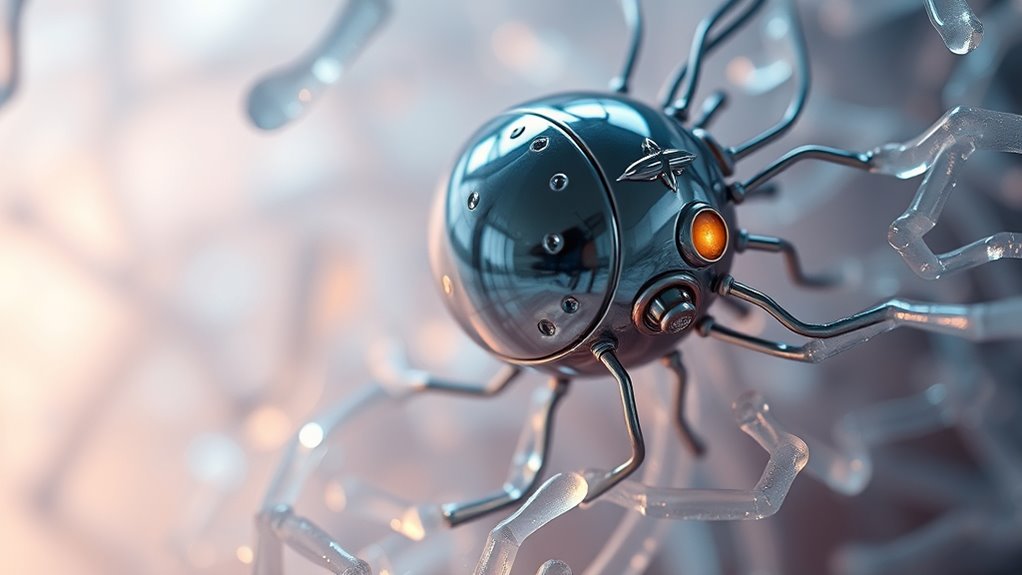Nanorobotics present ethical challenges you should consider, like privacy risks from data collection inside your body or sensitive environments. There’s potential for misuse, such as surveillance or harmful applications, which could threaten safety and trust. Unintended health or environmental consequences might also occur with unpredictable behavior. As development advances, questions about regulation, responsibility, and what should be permissible become vital. To explore how these issues are evolving and what solutions are being considered, keep exploring these topics further.
Key Takeaways
- Privacy concerns regarding data collection and potential misuse by nanorobots inside the human body.
- Dual use dilemmas where beneficial nanorobots could be repurposed for harmful surveillance or warfare.
- Risks of unintended consequences, such as malfunction or environmental harm from uncontrolled nanorobots.
- Need for comprehensive regulation and oversight to ensure responsible development and deployment.
- Ethical responsibility to define acceptable uses and prevent weaponization or malicious applications.

As nanorobotics advances, ethical concerns become increasingly critical to address, especially as these tiny machines begin to permeate medicine, industry, and even everyday life. You might find yourself excited about the potential benefits—targeted drug delivery, environmental cleanup, or enhanced manufacturing processes. But along with these advantages come serious issues like privacy concerns and dual use dilemmas that you can’t ignore. When nanorobots operate inside the human body or in sensitive environments, they could collect vast amounts of data without your knowledge. Imagine a future where your health data, movements, or even personal habits are monitored by autonomous nanodevices. This raises questions about consent, data security, and the potential for misuse. Who controls this information? How do you guarantee your privacy is protected when these tiny machines can access areas previously unreachable? These concerns aren’t hypothetical; they’re real, and they demand careful regulation. Additionally, establishing robust regulatory frameworks is essential to manage the development and deployment of nanorobotics responsibly.
Dual use dilemmas further complicate the ethical landscape. Nanorobots designed for medical purposes might also be repurposed for harmful applications, such as surveillance, espionage, or even biological warfare. You could see a scenario where technology developed for healing becomes a tool for control or harm. The same innovation that helps treat diseases could be weaponized or used for malicious surveillance, putting your rights and safety at risk. This duality creates a moral gray area, forcing you to contemplate not just what nanorobotics can do, but what it *should* do. Governments, corporations, and researchers all play a role in ensuring that these powerful tools aren’t exploited for nefarious ends.
Another layer of ethical complexity involves the potential for unintended consequences. Once deployed, nanorobots might behave unpredictably or malfunction, causing harm rather than helping. You might worry about the long-term impacts on health and the environment, especially if these machines are difficult to control or remove. The risk of unintended side effects raises questions about responsibility and accountability—who is liable if a nanobot causes harm? As these questions become more pressing, you’ll need robust frameworks and international cooperation to prevent abuse and ensure responsible development.
Frequently Asked Questions
How Can Nanorobotics Impact Global Health Disparities?
Nanorobotics can reduce global health disparities by improving access equity to advanced medical treatments. You might see these tiny devices deliver precise therapies, especially in underserved regions. However, if the technology divide widens, wealthier nations could benefit more, increasing inequality. To maximize positive impact, efforts should focus on making nanorobotics affordable and accessible worldwide, ensuring everyone benefits from these innovations regardless of their location or economic status.
What Are the Environmental Risks of Nanorobot Disposal?
You should be aware that improper disposal of nanorobots can lead to environmental pollution, contaminating water and soil. As waste management practices may not yet fully address nanomaterials, there’s a risk they could accumulate and cause harm to ecosystems. It’s essential to develop safe disposal methods and regulations to minimize these environmental risks, ensuring nanorobots don’t contribute to long-term pollution or pose health hazards.
Could Nanorobots Be Used for Unauthorized Surveillance?
Yes, nanorobots could be used for unauthorized surveillance, raising significant privacy concerns. If misused, they might enable unauthorized monitoring of individuals without consent, infringing on personal rights. You should be aware of these risks and advocate for strict regulations and safeguards. Proper oversight can help prevent malicious or intrusive use of nanorobots, ensuring they serve beneficial purposes without compromising privacy and security.
How Do We Ensure Informed Consent for Nanorobot Treatments?
To guarantee informed consent for nanorobot treatments, you should clearly explain the procedure, potential risks, and benefits, emphasizing patient autonomy. You need to encourage informed decision-making by providing accessible information and answering all questions honestly. Making certain patients understand their options allows them to make voluntary choices, respecting their rights. Regularly review consent as new information emerges, maintaining transparency and supporting ethical, patient-centered care.
What Legal Frameworks Govern Nanorobotics Research?
Imagine nanorobotics as a new frontier, like uncharted waters you’re enthusiastic to explore. You’re governed by international regulations that set safety and ethical standards, but these are still evolving. You also need to navigate intellectual property laws to protect innovations. While global agreements guide your research, you must stay current with jurisdictional laws, ensuring your work advances ethically and legally in this rapidly developing field.
Conclusion
As you navigate the frontier of nanorobotics, remember it’s a delicate dance on a razor’s edge. The tiny marvels you create hold immense power, like sparks that can ignite innovation or chaos. You must steer with caution, balancing progress with responsibility. Think of it as tending a garden of future possibilities—nurture wisely, for every choice shapes the landscape ahead. Embrace the challenge, but never lose sight of the ethical compass guiding your journey.








